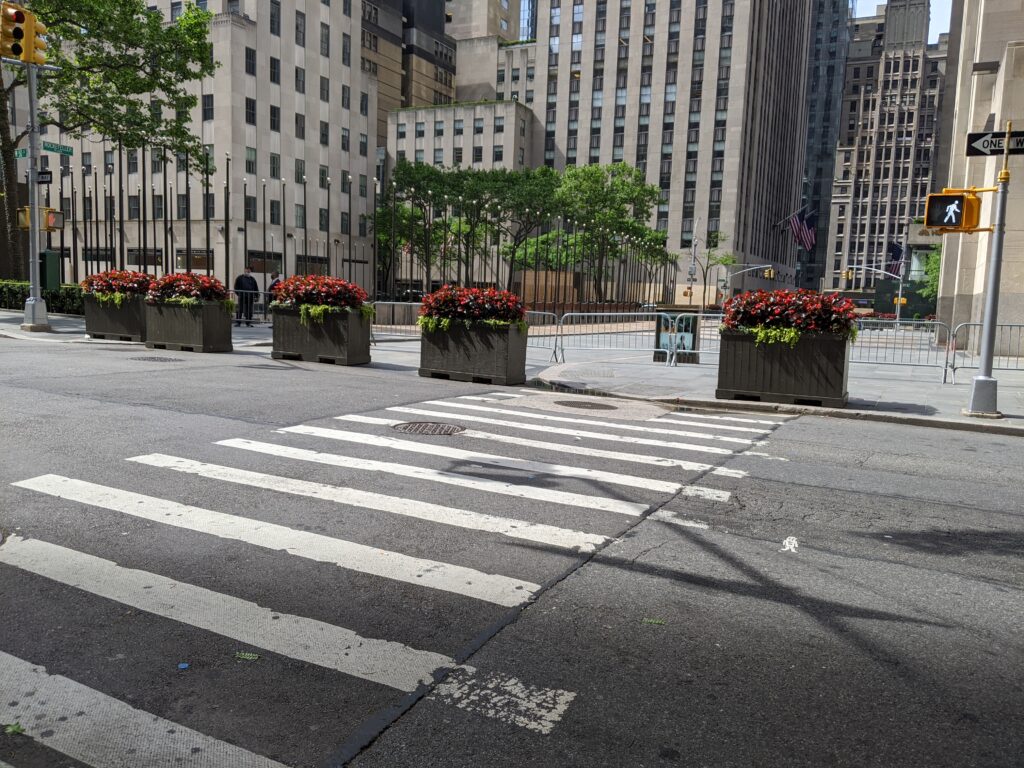If large companies find they can do just fine with relatively small office footprints and far greater structural reliance on distributed and remote working, who needs midtown or downtown New York? When oh when will people feel safe again getting on mass transit, or even in a crowded elevator?
Eric Kober of “Economics 21” summarized this case nicely a couple of weeks ago (emphasis ours):
In every crisis we ask the question, is New York finished? But this time could be different because the movement of office-based employees to working from home has created an uncertain outlook for Manhattan’s vast stock of office space. [A prevalent school of thought, represented by this] recent New York Times article suggests that even as the emergency eases, companies will liberalize work-at-home restrictions [… and] views these changes as a cause for alarm [as it] “would affect an entire ecosystem, from transit to restaurants to shops. Not to mention the tax base.” In reality, however, it’s simply a continuation of a long-standing trend which has not had any such effects, and shouldn’t in the future.
[…] Average square feet of office space per worker in North America dropped from 225 per worker in 2010 to 176 in 2012 [and] dropped further to 151 square feet in 2017. The trend was led by startups that were squeezing the amount of space they used in expensive cities like New York, by cutting down the size of workstations or by having employees work at long tables.
But while all of this was happening, Manhattan office vacancy rates went down and space became more, not less, expensive….
New York is the nation’s largest and most diverse labor market. Businesses providing advanced services (the primary users of office space) want to be here because the highly qualified labor force is here, and the labor force remains because the businesses are here. It’s a virtuous circle that has served the city well for decades, and even with advances in technology, person-to-person interaction provides a strong attraction for locating a business in New York. If some big companies lease less space, there will be (for a time) more vacant space, and asking rents will fall to the point where it makes sense for other businesses to expand or new businesses to start up. More people, not fewer, will be working in Manhattan offices in the future, at least some of the time. This is how the economy grows.
For an even longer-term perspective from a Gray Hair in the pantheon of intellectuals who have spent their lives thinking deeply about cities and urbanism, I turned to Richard Florida (not a pen name) who recently had this to say in an interview with Sidewalk Labs:
I think bigger cities will be ever more for the very young, and the very ambitious, and the super successful. … This is nothing new in the United States. People come to the cities to build their careers, embark on their lives, take advantage of a thick labor market, develop personal networks and connections that move them through their career, meet their partners and spouses and friends, and then they have kids, and they go, “Oh shit, it’s really expensive here and I can’t get a lot of space and it’s tough to navigate — I’ve gotta move.”
So I do think for smaller metros, there’s an opportunity that they’re part of a new choice set. Not for career formation and the first move out of college — especially for highly ambitious, highly talented people. But for the family formation move, yeah. …
I think most of those places have thrown money and incentives at companies, which is exactly the wrong approach for them. The right approach for them would be: “Hey, you can work remotely. You’re priced out of these big metros. You can have a fantastic life here.”
Can we specify that we have short-run and long-run issues here?
In the short run, meaning from now until whenever we navigate to The Other Side of this dratted pox (whether through powerful and effective therapeutics, a vaccine, brute-force herd immunity, or overwhelming sick-and-tiredness of all this), many of the structural features of the built infrastructure of large cities like New York simply do not work.
Mass transit is a challenge; elevators are a challenge; venues built specifically for assembling lots of people (meaning everything from a church or synagogue to a Broadway theater or museum to Yankee Stadium) don’t work very well. This is an awkward interim full of inhibitions, friction, transactions costs, and yes, risks to everyone’s health.
But ultimately we will get past the short run and face the long run.
Here’s where the optimist in me re-emerges. Truly global metropolises—New York and London being the ones I know best, but the list is long and rich—have no “substitutes.” Nowhere else can one find on full frontal display the power of density. Here’s what Florida was driving at when he said people come to major metros to “take advantage of a thick labor market, and develop personal networks and connections.”
What’s true for individuals is also true for organizations. The serendipity occurs when software engineers, set designers, portfolio managers, university professors, brand managers, robotics gurus, authors, actors, and yes, lawyers and bankers, run into each other. This doesn’t happen without serious scale.
Other cities—more than ever before, thankfully—have good restaurants, bookstores, coffeeshops, idiosyncratic labor-of-love stores, and so on. But only the global centers are packed densely enough to have hundreds, even thousands, of all of those.
Don’t take this the wrong way and dismiss it as a boast; I think it’s simply an insight into the difference in kind not just scale between metros of 100,000, 500,000, even a few million, and the indisputably global hubs destinations. In the global hubs, not only are the top [law firms, banks, medical centers, restaurants, publishers, galleries, concert venues, etc.] utterly superb, but the deep, deep bench of less conspicuous players down the line is very good indeed.
But Law Land is its own not-so-little microeconomy, and in terms of Law Land, we’re seeing three primary forces emerge.
Each is strong: One is an acceleration of a long-established prior pattern, one is something no one saw coming in the least, and the last is–in terms of economics–pure and undiluted good news.
- The Acceleration: Segmentation is here to stay, and here to gain force. The strongest firms (reputation, brand name, sheer caliber of talent, deeply embedded client relationships) are going from strength to strength, while others with patchier client relationships, clients unfortunately concentrated in the “wrong” sectors (retail, hospitality, travel/leisure, airlines), and clients in serious financial stress of their own–less able to pay their bills, to call it what it is–have a steeper hill in front of them. One could envision scenarios where the firms under greater pressure would unite as never before and come out stronger on the other side, but that’s not where a betting person would put their money.
- The Unforeseen: Now that we have all been thoroughly inoculated with Zoom, Webex, Microsoft Teams, LoopUp, and all the rest, it is beginning to dawn on clients that New York firms can serve them as easily as local firms, bricks and mortar be damned. This is happening in Texas, Silicon Valley, Chicago, Toronto, and elsewhere. Of course, as we strive to make a habit of reminding our readers, “averages mislead.” Not all New York firms are equal Zoom destinations. See #1 above.
- The Good News: This recession could hardly be more different from the 2008/9 financial system seizure/meltdown. In that recession, deals, strategic and financial, collapsed, because there was no cash, no credit, and no functioning capital markets. Here investors have hoards of cash, and their clients are demanding they put it to use. For one thing, many assets are substantially cheaper than they were in February. For another, the Fed is super-duper-accommodating, and fiscal policy isn’t exactly on a parsimony tear. Few things are more reliable sources of activity for sophisticated law firms than a hot deal market. See ##’s 1 & 2 above.
Adding it all up, New York may not have it so bad, after all.
This is, of course, to discount the odds of social, economic, and political divisions growing so insurmountable that the US becomes ungovernable, or that we fail to treasure our priceless democracy and stand up for the rule of law in the face of deranged and menacing leadership.
Meanwhile, we’re still living in the short-run. Here’s a picture I took of Rockefeller Center yesterday morning around 10:00 am:

In terms of being “open for business,” New York City/Metro has a ways to go.
But strong signs of resilience are already showing. Not only have the front line soldiers in the Covid19 war come through as genuine heroes (the healthcare workers, grocery store clerks, delivery people of every stripe, subway and bus drivers, who aren’t paid remotely enough to do what they do so that the rest of us can WFH), but people at every level are stepping up. New York is down, but it’s never yet been out.




Funny that five of the six states that depend on the federal government for more than 40% of their general revenue have Republican-controlled legislatures: Montana (40.6%), Mississippi (43.3%, highest in the nation), Kentucky (40.9%), Louisiana (42.7%), Arizona (41.2%), and New Mexico (41.2%, the only one with a Democratic legislature).
I don’t think the pandemic/WFH really changes much in terms of clients in other cities adding (or deleting) NY firms to their consideration set. The elite white shoe New York City-based firms will continue to cherrypick bet the company type work from clients all over the country. If you need the heavy duty capabilities those firms provide, you already know the players in that world and will generally pay the freight. To borrow a phrase, twas ever thus? The nature of clients’ needs in those particular areas have not and will not change.
The rest of the run the company work? I doubt clients are moving that back to New York firms because they can now see their lawyers on Zoom, short of some substantial discounts of sticker price by those firms. If anything, there is even more price pressure on this type of work. And mounting every day. And because it so expensive to operate in NYC, even if there is a willingness to discount rates (or even do some creative AFAs, which, let’s face it, heavily favor clients right now), there’s an effective floor on what firms in Manhattan can charge and still keep the doors open at minimum scale. Although maybe this changes a bit now with real estate footprints in play on the cost side.